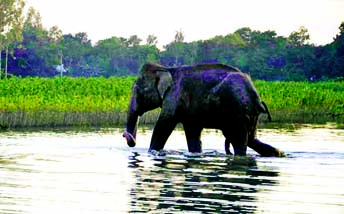
BSS, Jamalpur :
A three-member Indian rescue team yesterday left Jamalpur on the their way back home virtually leaving to Bangladesh officials the task of salvaging an elephant which was washed across the border by flood waters nearly six weeks ago.
“The elephant is still stranded in waters which disrupted the joint rescue mission . . . they (Indian team) left the scene as Bangladesh’s forest officials expect to rescue the giant animal once the flood water is receded,” a forest official told BSS. Wildlife inspector Ashim Mollik, who is familiar with the rescue campaign for the past several weeks, said the Indian team left the scene as the elephant could not be driven to a dry piece of land to be tranquilized for subsequent treatment and transportation. “We (Bangladeshi forest officials) are now waiting for the moment when the elephant gets off the water,” he said adding that the animal was currently roaming in swamps at Sidhuli union of Madarganj upazila in Jamalpur.
Bangladesh and India launched a massive campaign to salvage the wild elephant on August 4 when a three member Indian expert team led by a retired chief conservator of forest of theirs reached the scene in Jamalpur.
Chief conservator of forest Mohammad Yunus Ali earlier told BSS that the joint team with veterinary surgeons as members was equipped with tranquilizers and other equipment to rescue the elephant which was languishing in marshy lands along the rivers. “India will to take it back if possible, otherwise we will keep the elephant,” Bangladesh’s forest chief said, pointing out that in past two nearly identical cases in 2004 and 2013, the initiative to return an elephant succeeded while another died on its way back.
Ali said India kept in touch with Bangladesh’s forest department since the precious animal crossed the common Brahmaputra River on June 27. A forest official who was stationed at the scene to monitor the elephant’s behavior and activities said the wild animal remained calm though it showed some signs of abnormal behavior as it was forced to live in swamps for weeks despite being habituated in hilly forest environment.
“The elephant looks tired and weak as it is finding limited items of food like rice plants and sugarcane plants or some banana trees supplied by us. Yet it remained non-violent,” Mollik earlier said.
Talking to BSS yesterday, he said the elephant was still out of danger despite being exposed to a hostile condition as it could not get the scope to take rest on a dry piece of land as higher lands in the neighbourhood.
A huge crowd of people took makeshift refuge on higher lands at the scene leaving their homes inundated by flood waters. The elephant, weighing around four tonnes, crossed the common Brahmaputra River on June 27 and soon grabbed media attention as it was followed by hundreds of people in boats every day requiring police deployment to keep it undisturbed.

